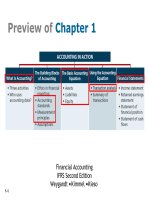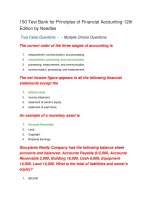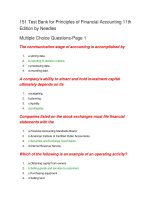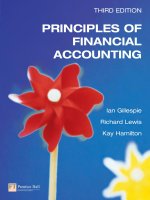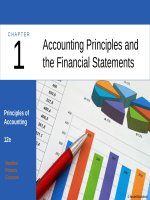Lecture Principles of financial accouting - Chapter 1: Accounting in business
Bạn đang xem bản rút gọn của tài liệu. Xem và tải ngay bản đầy đủ của tài liệu tại đây (2.21 MB, 37 trang )
Chapter 1
Accounting in Business
PowerPoint Authors:
Susan Coomer Galbreath, Ph.D., CPA
Charles W. Caldwell, D.B.A., CMA
Jon A. Booker, Ph.D., CPA, CIA
Cynthia J. Rooney, Ph.D., CPA
Winston Kwok, Ph.D., CPA
McGrawHill/Irwin
Copyright © 2011 by The McGrawHill Companies, Inc. All rights reserved.
1 2
C 1
Importance of Accounting
Accounting
Identifying
Select transactions and events
Recording
Input, measure and classify
Communicating
Prepare, analyze and interpret
1 3
C 2
Users of Accounting Information
External Users
•Lenders
•Consumer Groups
•Shareholders •External Auditors
•Governments •Customers
Internal Users
•Managers
•Officers/Directors
•Internal Auditors
•Sales Staff
•Budget Officers
•Controllers
1 4
C 2
Users of Accounting Information
External Users
Financial accounting
provides external users
with financial statements.
Internal Users
Managerial accounting
provides information needs
for internal decision-makers.
1 5
C 2
Opportunities in Accounting
1 6
C 3
Ethics - A Key Concept
Beliefs that
distinguish right
from wrong
Accepted standards
of good and bad
behavior
1 7
C 3
Ethics - A Key Concept
1 8
C 4
Generally Accepted Accounting
Principles
Financial accounting practice is governed by concepts
and rules known as generally accepted accounting
principles (GAAP).
Relevant Information
Affects
Affects the decision of its
its users.
Reliable Information
Is trusted by
by users.
users.
Comparable
Information
Is helpful in
in contrasting
organizations.
1 9
C 4
Setting Accounting Principles
Financial
Financial Accounting
Accounting Standards
Standards Board
Board
is
is the
the private
private group
group that
that sets
sets both
both
broad
broad and
and specific
specific principles.
principles.
The Securities and Exchange Commission is the
government agency that establishes reporting requirements
for companies that issue stock or shares to the public.
The International Accounting Standards Board (IASB)
issues International Financial Reporting Standards that
identify preferred accounting practices to create harmony
among accounting practices of different countries.
1 10
C 4
International Standards
The International Accounting Standards Board (IASB), an
independent group (consisting of 16 individuals from many
countries), issues International Financial Reporting Standards
(IFRS) that identify preferred accounting practices.
IASB
1 11
C 4
Principles and Assumptions
of Accounting
Revenue Recognition Principle
1. Recognize revenue when it is earned.
2. Proceeds need not be in cash.
3. Measure revenue by cash received
plus cash value of items received.
Matching Principle
A company must record its expenses
incurred to generate the revenue reported.
Cost Principle
Accounting information is based on
actual cost. Actual cost is
considered objective.
Full Disclosure Principle
A company is required to report the
details behind financial statements that
would impact users’ decisions.
1 12
C 4
Accounting Assumptions
Now
Future
Going-Concern Assumption
Reflects assumption that the business
will continue operating instead of being
closed or sold.
Monetary Unit Assumption
Express transactions and events in
monetary, or money, units.
Business Entity Assumption
Time Period Assumption
A business is accounted for
separately from other business
entities, including its owner.
Presumes that the life of a company can
be divided into time periods, such as
months and years.
1 13
C 4
Forms of Business Entities
Sole
Sole
Proprietorship
Proprietorship
Partnership
Partnership
Corporation
Corporation
1 14
C 4
Characteristics of Businesses
Characteristic
Proprietorship Partnership Corporation
Business entity
yes
yes
yes
Legal entity
no
no
yes
Limited liability
no*
no*
yes
Unlimited life
no
no
yes
Business taxed
no
no
yes
One owner allowed
yes
no
yes
* Proprietorships and partnerships that are
set up as LLCs provide limited liability.
1 15
C 4
Corporation
Owners of a corporation are called
shareholders (or stockholders). Shareholders are
not personally liable for corporate acts. When a
corporation issues only one class of shares, we
call it ordinary shares (or share capital).
1 16
A 1
Transaction Analysis and the
Accounting Equation
Accounting Equation
Assets
= Liabilities + Equity
1 17
A 1
Assets
Cash
Accounts
Receivable
Vehicles
Store
Supplies
Notes
Receivable
Resources
owned or
controlled by
a company
Land
Buildings
Equipment
1 18
A 1
Liabilities
Accounts
Payable
Notes
Payable
Creditors’
claims on
assets
Taxes
Payable
Wages
Payable
1 19
A 1
Equity
Owner’s
Claims on
Assets
1 20
P 1
Transaction Analysis Equation
The accounting equation MUST remain in
balance after each transaction.
Assets
Assets
=
Liabilities
Liabilities
+
Equity
Equity
1 21
P 1
Transaction 1: Investment by Owners
On December 1, Chas Taylor invests
$30,000 cash to start a consulting business.
The accounts involved are:
(1) Cash (asset)
(2) Owner Capital (equity)
1 22
P 1
Transaction 2: Purchase
Supplies for Cash
Chas Taylor’s company, FastForward
purchases supplies paying $2,500 cash.
The accounts involved are:
(1) Cash (asset)
(2) Supplies (asset)
1 23
P 1
Transaction 3: Purchase
Equipment for Cash
FastForward purchases equipment for
$26,000 cash.
The accounts involved are:
(1) Cash (asset)
(2) Equipment (asset)
1 24
P 1
Transaction 4: Purchase
Supplies on Credit
FastForward purchases Supplies of $7,100 on
account.
The accounts involved are:
(1) Supplies (asset)
(2) Accounts Payable (liability)
1 25
P 1
Transaction 5: Provide
Services for Cash
The company provides consulting services
receiving $4,200 cash.
The accounts involved are:
(1) Cash (asset)
(2) Revenues (equity)


